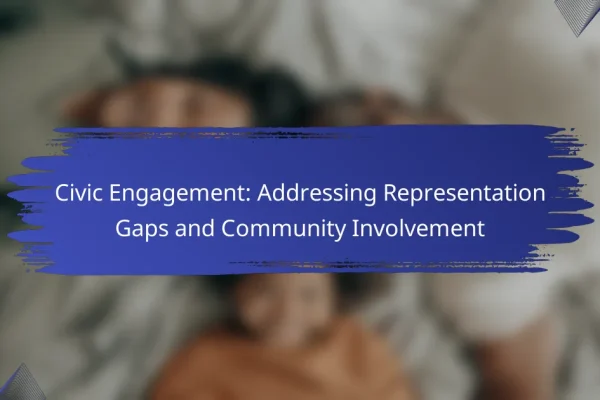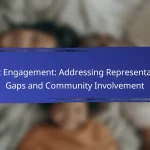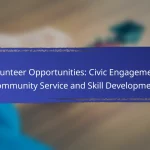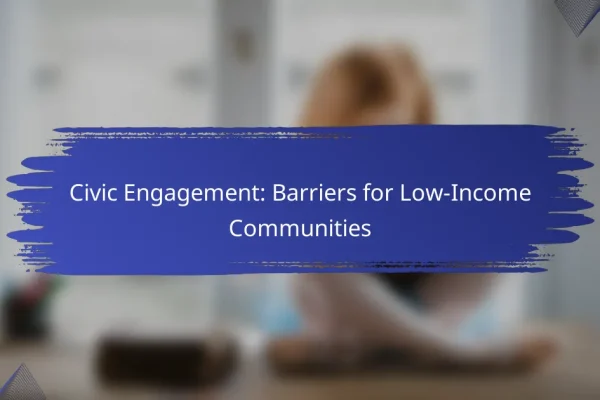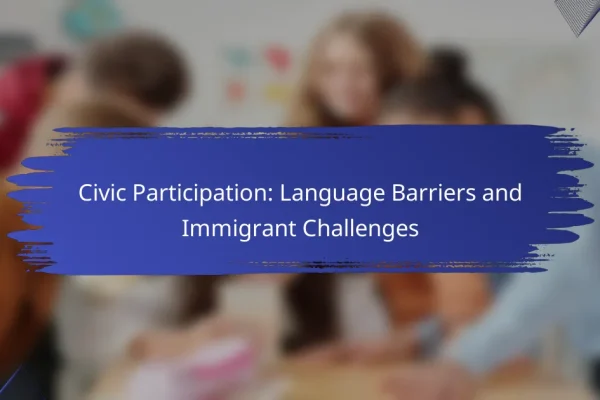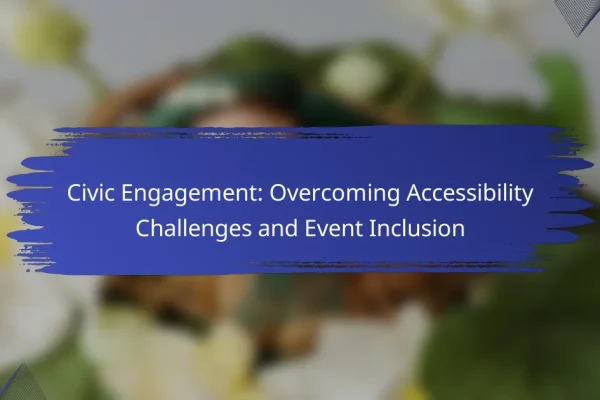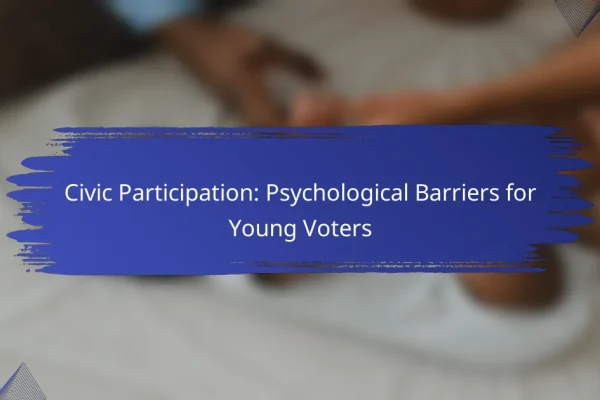What are the key civic engagement challenges in urban areas?
Urban areas face several significant civic engagement challenges that hinder active participation in democratic processes. These challenges include voter apathy, lack of access to information, socioeconomic barriers, the digital divide, and community disconnection.
Voter apathy
Voter apathy refers to the lack of interest or motivation to participate in elections and civic activities. This phenomenon is often driven by feelings of disillusionment with political processes or a belief that individual votes do not matter.
To combat voter apathy, community organizations can implement outreach programs that emphasize the importance of voting and how it impacts local issues. Engaging storytelling and relatable messaging can help rekindle interest in civic participation.
Lack of access to information
A lack of access to reliable information can severely limit civic engagement in urban areas. Many residents may not have easy access to details about candidates, policies, or voting procedures, which can lead to confusion and disengagement.
Local governments and civic groups should prioritize clear communication strategies, utilizing multiple formats such as flyers, community meetings, and social media to disseminate vital information. Ensuring that materials are available in multiple languages can also enhance accessibility.
Socioeconomic barriers
Socioeconomic barriers can prevent individuals from participating in civic activities. Factors such as financial constraints, lack of transportation, and demanding work schedules can limit opportunities for engagement.
Addressing these barriers may involve providing resources like transportation assistance or flexible voting hours. Community initiatives that offer support for low-income families can also encourage greater participation in civic life.
Digital divide
The digital divide refers to the gap between those who have easy access to digital technology and those who do not. In urban areas, this divide can affect participation in online civic engagement platforms and access to information.
To bridge this gap, cities can invest in public internet access points and digital literacy programs. Ensuring that all residents have the skills and tools to engage online is crucial for modern civic participation.
Community disconnection
Community disconnection occurs when individuals feel isolated from their neighbors and local institutions, leading to decreased civic engagement. This disconnection can stem from urban living conditions, such as high population density and transient populations.
Building community connections can involve organizing local events, neighborhood meetings, and volunteer opportunities that foster relationships among residents. Strengthening community ties can enhance collective efficacy and encourage civic involvement.
How can technology enhance civic engagement?
Technology can significantly enhance civic engagement by providing accessible tools for participation and communication. Through mobile apps, online platforms, and social media, individuals can easily register to vote, discuss community issues, and mobilize support for causes.
Mobile applications for voter registration
Mobile applications streamline the voter registration process, making it easier for citizens to register and check their status. Many states in the U.S. allow residents to register via apps, which can reduce registration time to just a few minutes.
When using these apps, ensure they are official and secure. Look for features like real-time updates on registration deadlines and reminders for upcoming elections to stay informed.
Online platforms for community discussions
Online platforms facilitate community discussions by providing spaces for residents to share ideas and voice concerns. Websites and forums dedicated to local issues can foster dialogue among citizens and local officials.
Consider using platforms that allow for moderated discussions to maintain a respectful environment. Engaging in these discussions can help build community consensus and drive local initiatives.
Social media campaigns
Social media campaigns are powerful tools for raising awareness and mobilizing support for civic causes. Platforms like Facebook, Twitter, and Instagram can reach a broad audience quickly, making them ideal for promoting events or initiatives.
To run an effective campaign, focus on clear messaging and engaging visuals. Utilize hashtags to increase visibility and encourage community members to share their experiences and opinions, amplifying the campaign’s reach.
What role do local governments play in civic engagement?
Local governments are crucial in fostering civic engagement by creating opportunities for residents to participate in decision-making processes. They facilitate communication between the community and public officials, ensuring that citizens’ voices are heard and considered in governance.
Facilitating public forums
Local governments often organize public forums to encourage community dialogue on various issues. These forums provide a platform for residents to express their opinions, ask questions, and engage directly with elected officials. Effective forums typically have clear agendas, are well-publicized, and allow for open discussions.
To maximize participation, local governments should consider holding forums at accessible locations and times that accommodate diverse community members. Utilizing online platforms can also enhance engagement, especially for those unable to attend in person.
Providing resources for community organizations
Local governments support civic engagement by offering resources to community organizations that promote public participation. This can include financial assistance, training programs, and access to meeting spaces. By empowering these organizations, local governments can amplify community voices and foster grassroots initiatives.
It is essential for local governments to identify and collaborate with key community organizations, ensuring they align their resources with the specific needs of the community. Regular communication and feedback mechanisms can help refine these support efforts.
Implementing participatory budgeting
Participatory budgeting allows residents to have a direct say in how a portion of the local budget is spent. This process typically involves community meetings where citizens can propose and vote on budget priorities, fostering transparency and accountability in local governance.
When implementing participatory budgeting, local governments should clearly outline the budget amount available for participation and establish a timeline for the process. Engaging a diverse group of residents in discussions can lead to more equitable outcomes and better reflect community needs.
What are effective strategies for increasing voter participation?
Effective strategies for increasing voter participation include targeted outreach, community partnerships, and offering incentives. These approaches can engage diverse populations and make the voting process more accessible and appealing.
Outreach programs in schools
Outreach programs in schools can play a crucial role in educating young people about the voting process. By integrating civic education into the curriculum, schools can foster a sense of responsibility and encourage students to participate in elections as soon as they are eligible.
Programs can include mock elections, discussions about civic duties, and partnerships with local election offices to provide resources. Engaging students through interactive activities can significantly increase their interest in voting.
Partnerships with local nonprofits
Collaborating with local nonprofits can enhance voter participation by leveraging their community connections. Nonprofits often have established trust and can effectively reach underrepresented groups, providing them with essential information about the voting process.
These partnerships can facilitate voter registration drives, informational workshops, and transportation services to polling places. By working together, organizations can create a more inclusive environment that encourages civic engagement.
Incentives for voting
Offering incentives for voting can motivate individuals to participate in elections. Incentives may include discounts at local businesses, raffle entries, or even small cash rewards, depending on local regulations.
Communities can implement programs that reward voters for their participation, making the act of voting more appealing. However, it is essential to ensure that these incentives comply with election laws to avoid any legal issues.
How can community organizations address civic engagement barriers?
Community organizations can tackle civic engagement barriers by implementing targeted strategies that educate and involve citizens. These strategies often focus on raising awareness of civic rights and fostering collaboration among diverse groups to create inclusive environments for participation.
Workshops on civic rights
Workshops on civic rights are effective tools for educating community members about their legal entitlements and responsibilities. These sessions can cover topics such as voting rights, local governance, and civic duties, empowering participants to engage more actively in their communities.
To maximize impact, organizations should consider tailoring workshops to specific demographics, such as youth, immigrants, or marginalized groups. Providing materials in multiple languages and using accessible formats can further enhance participation.
Collaborative events with diverse groups
Collaborative events that bring together diverse groups can break down barriers to civic engagement by fostering understanding and cooperation. These events might include community forums, cultural festivals, or joint service projects that encourage interaction among different demographics.
When planning these events, organizations should prioritize inclusivity by ensuring representation from various communities. Engaging local leaders and influencers can also help draw participants and create a welcoming atmosphere, ultimately leading to stronger civic participation.
What metrics can measure civic engagement success?
Metrics for measuring civic engagement success include various indicators that reflect the level of participation and involvement of citizens in democratic processes. Key metrics often focus on voter turnout, community participation in local events, and engagement in civic organizations.
Voter turnout rates
Voter turnout rates are a primary metric for assessing civic engagement, indicating the percentage of eligible voters who participate in elections. High turnout rates typically reflect a strong interest in civic affairs and can vary significantly based on factors like election type, demographic groups, and local issues.
To evaluate voter turnout, consider both presidential and midterm elections, as these often yield different participation levels. For instance, presidential elections may see turnout rates in the range of 50-70%, while midterm elections often attract lower participation, typically around 30-50%.
To improve voter turnout, communities can implement strategies such as voter education campaigns, simplifying registration processes, and providing accessible polling locations. Engaging local organizations to promote participation can also enhance turnout rates, especially among underrepresented groups.
